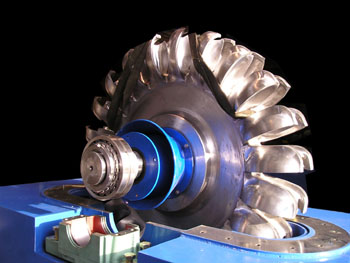Part 3: Evaluating Systems & Suppliers
Bookmark this page (Ctrl+D)
![]() View/Print PDF Version
View/Print PDF Version
Guide Navigation
- Introduction
- Hydro Systems Overview
- Planning Your Own Hydro System
-
Evaluating Systems & Suppliers
- Turbine System Quality
- Turbine Runner
- Turbine Housing
- Other Turbine Considerations
- Turbine Supplier
How to Recognize Quality and Durability
As we’ve shown, a hydro system is both simple and complex. The concepts behind water power are simple: it all comes down to Head and Flow. But good design requires advanced engineering skills, and reliable operation requires careful construction with quality components.
What Makes a Quality Turbine System
Think of a turbine system in terms of efficiency and reliability. In a perfect world, efficiency would be 100%. All the energy within the water would be transformed to the rotating shaft. There would be no air or water turbulence, and no resistance from bearings. The runner would be perfectly balanced. The signs of energy loss – heat, vibration and noise – would be absent. Of course, the perfect turbine would also never break down or require maintenance.

Quality components and careful machining make a big difference in turbine efficiency and reliability.
Obviously no turbine system will ever achieve this degree of perfection. But it’s good to keep these goals in mind, because better efficiency and reliability translate to more power and a lower cost-per-watt. Here are just a few of the things to consider when selecting a turbine system:
Turbine Runner
The runner is the heart of the turbine. This is where water power is transformed into the rotational force that drives the generator. Regardless of the runner type, its buckets or blades are responsible for capturing the most possible energy from the water. The curvature of each surface, front and rear, determines how the water will push its way around until it falls away. Also keep in mind that any given runner will perform most efficiently at a specific Head and Flow. The runner should be closely matched to your site characteristics.
Look for all-metal runners with smooth, polished surfaces to eliminate water and air turbulence. One-piece, carefully machined runners typically run more efficiently and reliably than those that are bolted together. Bronze manganese runners work well for small systems with clean water and Heads up to about 500 feet. High-tensile stainless steel runners are excellent for larger systems or abrasive water conditions. All runners should be carefully balanced to minimize vibration, a problem that not only affects efficiency but can also cause damage over time.
Turbine Housing
The turbine housing must be well built and sturdy, as it manages forces of the incoming water as well as the outgoing shaft power. In addition, its shape and dimensions have a significant affect on efficiency. For example, consider a Pelton-type turbine. As an impulse turbine, it is driven by one or more jets of water, but spins in air. This means that both hydrodynamic and aerodynamic forces must be considered in the design of the housing. It must minimize the resistance from splash and spray and smoothly exhaust tail waters, yet also be sized and shaped properly to minimize losses due to air turbulence. Similarly, housings for high-Flow designs like Crossflow and Francis turbines must be precisely engineered to smoothly channel large volumes of water through the turbine without causing pockets of turbulence.
Look for a smoothly welded housing that is carefully matched to the proper runner for your site. Keep in mind that both the water forces and the runner will be producing considerable torque, so the housing material and all fittings should be heavy-duty. Mating surfaces, such as pipe flanges and access covers, should be machined flat and leak-free. Since water promotes rust and corrosion, make sure all vulnerable surfaces are protected with high quality powder coat or epoxy paint. All bolts should be stainless steel.
Other Turbine Considerations
All surfaces that carry water can impact efficiency, from the intake to your pipeline to the raceway that carries the tail waters away from your powerhouse. Look for smooth surfaces with no sharp bends, Jets and flow control vanes should be finely machined with no discernable ripples or pits.
Efficiency is important, but so are durability and dependability. Your hydroelectric project should deliver clean power without interruption. The quality of components – and their installation – can make a big difference on the quality of your life in the years to come.
Look for meticulous workmanship in the design and construction of seal systems, shaft material and machining, and all related components. Pay particular attention to the selection and mounting of bearings; they should spin smoothly, without grating or binding.
Turbine Supplier
When it comes to suppliers, there is no substitute for experience. While the principles of hydro power can be mastered indoors, it is real world experience that teaches both the highlights and pitfalls of diverting water from a stream, pressurizing it, and forcing it through a turbine. A turbine supplier with many years of field experience will be invaluable to you as your design and build your hydro system.
Look for an experienced supplier that specializes in the size and type of hydro system you intend to build. A good supplier will work with you, beginning with your measurements of Head and Flow, to help you determine the right pipeline size, Net Head, Design Flow, turbine specifications, drive system, generator, and load management system. You should be able to count on your supplier to make suggestions for optimizing efficiency and dependability, including their effects on cost vs. performance.
A good turbine supplier is your partner, and should take a personal interest in your success. After all, a satisfied customer is very good for business.
< BACK | NEXT >